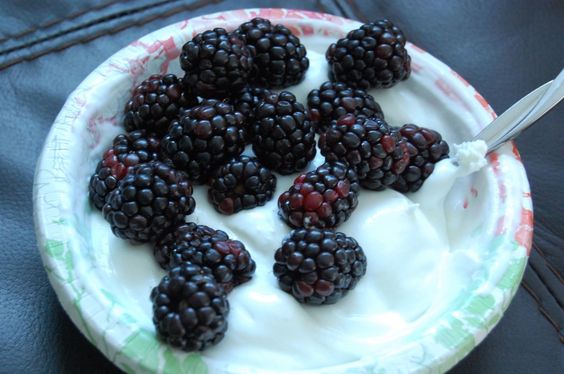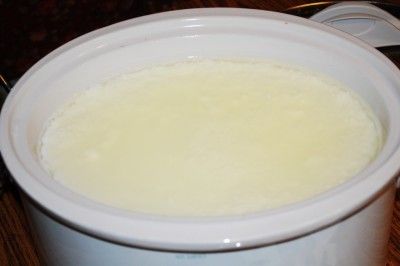
Greek yogurt is a great source of protein and probiotics. It’s thick and creamy even when made with skim milk. The only problem is it can get expensive! A 48 ounce container from Costco is around $6, but I can make 64 ounces at home for the price of a gallon of milk. This week Aldi has milk on sale for $1.65 a gallon! It’s yogurt making time :).
I like to do a whole gallon at once, because I use yogurt for a lot of things–eating with fruit, pancake topping, sour cream substitute, to make dip and salad dressing, as a base for cream sauces etc. It’s a fabulous high protein snack for everyone in the family. If you use less, you can cut everything in half and do just a half gallon if you use less yogurt. So here’s how I make it:

Pour 1 gallon of milk in a 5 quart slow cooker. Place on low for 2-3 hours or until it is 180 degrees. Do not let the milk boil! If you have a digital thermometer with an alarm, you can walk away and forget about it. You can use any kind of milk–skim to whole. I prefer skim for the lower calories and we are used to it. Whole milk yogurt is delightfully creamy though.
Turn off the slow cooker and let the milk sit until it has cooled to 110-120 degrees. (2-3 hours) I know heating the milk feels like an extra step if you are just going to cool it down, but it’s necessary to unravel the proteins and allows the yogurt to thicken. I’ve made raw milk yogurt before and it doesn’t get as thick.
Take 1/2 cup of plain yogurt (reserved from your last batch or purchased) and mix it with 1 cup of the warm milk from your slow cooker. Then stir this mixture into the rest of the warm milk. It would seem like adding more yogurt starter would just make yogurt faster and thicker–but it doesn’t work that way. More is not better. 1/2 cup per gallon is perfection.
Cover with the lid and wrap the whole thing in bath towels to insulate. Keep the slow cooker turned off and allow it to sit overnight. In the morning it will look like this:
 You can see the whey separated and floating on the top with the yogurt solids underneath. If you stir all this together, you will have regular plain yogurt.
You can see the whey separated and floating on the top with the yogurt solids underneath. If you stir all this together, you will have regular plain yogurt.
To make Greek Yogurt: Layer a large bowl with a large colander and line with 3 layers of cheese cloth. Pour your yogurt into this and allow to drain without stirring until half of the volume is reduced. Save the nutritous clear whey for baking and use it like buttermilk in pancakes, biscuits, bread etc.
Take the strained yogurt and put it in your electric mixture with the wisk attachment and whip. If it’s too dry add a little fresh milk (or cream) until it has the moistness and consistency you like.
It should be very thick and creamy when you are done. This recipe yields 1 gallon of plain yogurt or 1/2 gallon of Greek Yogurt for around $3. This is roughly 1/4 the cost of buying the same amounts at Costco and requires very little hands on time.
If your yogurt doesn’t set up, you can leave it another day. I’ve forgotten about it before and left it for 24 hours. The yogurt was perfect and the cultures kept the milk from spoiling. If it doesn’t work at all, it is possible the yogurt cultures weren’t alive. This happens if the milk is too hot when they are added (high heat will kill them.) Or if the starter was too old. It works best if you can make yogurt once a week or every other week and use 1/2 cup from the previous batch to keep the cultures alive and happy.
We love homemade yogurt. I”ll never look back. I was using the crock pot method, but I switched to just making it on the stovetop and finishing it in the oven. We like the texture better and it gets thicker…..but I love having the crock pot option too. 🙂 Anything in the crock pot just tickles me pink.
Thanks for reposting!
@Angela:
My wife mentioned this idea as we love yogurt and try to live frugally. Thanks for sharing the info.
@Stacy:
Can you share your method?
I’d love to try this, but I’m scared! If it comes out nasty I’ll be scarred for life! Do you flavor yours at all? How do you make your dressings, cream sauces, etc with homemade yogurt???
tiannamae.blogspot.com
TiAnnaMae–You are cracking me up! If you are worried about it, start with a smaller amount. Smaller amounts of milk will heat up faster though than the gallon–take that into account. I flavor mine with stevia drops or stevia packets like Purevia. For salad dressings and dips I use it in place of sour cream in my recipes. I add it to cream sauces at the end of cooking to make them creamier and richer. It is especially nice in beef stroganoff and tuna casserole.
Angela, I normally sweeten mine by the bowl. Do you sweeten your entire batch at once? And if so, how much stevia do you use?
Stacy, I sweeten mine by the bowl too. 1 Tablespoon of cocoa and 1 packet of purvia for 1 cup of yogurt. Or 5 drops of liquid stevia (chocolate or vanilla are my favorites) to 1 cup yogurt.
This sounds great!
Stacy, I am interested in the stovetop method as well. Do tell!
How long will the yogurt keep in the fridge?
I’ve never tested it for very long since we gobble it up, but about 2 weeks is my guess.
What kind of yogurt is best to start with, for the starter., since I’ve never done this before?
Thanks,
Wendi
Wendi, any brand of plain yogurt that still contains live cultures will do. I use Mountain High brand that I purchase from Costco.
Oh this is YUMMY! Thanks for the recipe, I made it last night. Even on high, my slowcooker would only get the milk to 173. I had to take the insert out of my slowcooker and heat it on the stove to reach 180, which seems to be just at the boiling point. I had a bowl with some honey on it. I’m going to make Tzatziki with it tomorrow.
I don’t have a thermometer to check the temperature of the slow cooker. Do I really need one or can I get away with just keeping it on low and following the timeline that you have provided?
Thanks!
Anita, the only danger is getting the milk too hot and killing your yogurt cultures. The milk has to be below 120 and closer to 100 for the yogurt to culture properly. You can learn to test it with your wrist though.
Thank you so much for posting this recipe! I made it the other day and it is SO GOOD! Being pregnant, I’ve been trying hard to get in enough protein each day, and I find myself eating (and craving) lots of yogurt. I love that I can add my own sugar and fruit and know that it’s got to be better for me than what I could go buy at the store. Plus, since it’s SO much cheaper to make it than buy it, I don’t feel guilty about eating lots of it!
Angela, thank you for sharing this. I tried it instead of on the stove and like the crock pot method better. I still just set the pan (now crock pot) inside of a very thick blanket to cure it. I tried the Greek style yogurt plain and found I liked it better with about a teaspoon of homemade jam swirled in.
Anybody got the nutrition facts on this?
Dominick, This would depend on what type of milk you started with and how long you let it strain. If you use skim milk, you can look up a generic nonfat Greek yogurt for the nutrition facts. If I remember right it has around 130 calories and 22 grams of protein per cup.
How about using a milk other than cow’s? Goat’s, rice or coconut milk? My son is off of gluten and dairy for eczema but loves yougrt. I have been spending a small fortune on individually packaged soy yogurt and would love to be able to make my own! Has anyone tried non-cow milk?
Meredith, You can make non-dairy yogurt at home. I just googled it this week! Basically you will need to add sugar as food for the yogurt cultures and find a non-dairy culture source. I’m not sure how the lower protein content affects the yogurt. This would be less apparant when using soy milk as with other types of non-dairy milk.
Thank you so much for posting this recipe! I AM PUERTO RICAN AND WAS LOOKING FOR A RECIPE AS IS, AS HERE THE GREEK YOGURT IS VERY EXPENSIVE
I DID YESTERDAY AND IS VERY TASTY , THANK YOU
Brewing in my slow cooker now. In Canada, what would be the best brands to mix with?
What a great idea !!! I’m going to give it a try.
I made a batch last night, and this morning the yogurt is still quite thin and runny…maybe the consistency of buttermilk. I used a thermometer to ensure I hit 180 degrees before taking it off the heat, and let it cool to 118 before mixing in the starter yogurt. Any thoughts?
Mike, Several things could be going on. Your starter could be too old. Yogurt cultures are strongest within the first week, so it works best with fresh yogurt. Sometimes, it just needs a little more time to culture–up to 24 hours is okay. It will get slightly more tart with time, but it still tastes okay to me. The lower your milk fat content the runnier your yogurt will be, but you should still see a big separation of whey (yellowish clear) with the whiter yogurt underneat when it is ready. At first it will seem like the yogurt is thick enough to cut with a knife, but when you go to pour it into the strainer, it pours quite readily. I hope this helps.
Also, if your first stab at yogurt is a flop, you can rewarm your milk and try again. (Another important key is making sure hte yogurt stays as near 100 degrees F, during the entire incubation process. I pack mine in towels and blankets for insulation.
I stumbled upon this from Pinterest, and was very hesitant to try it. I was sure I would mess it up somehow. After hours of self-doubt and fears, it came out beautifully. A little thin, even after straining it, but I also used fat free milk, so that’s probably to be expected. I let it incubate for close to 12 hours because I mistakenly started the whole process in the late morning, which meant I would have had to wake up at 2 a.m. to finish it (ha! not happening). I cooked down some strawberries and agave, then blended it up and added it to the finished product for some sweetness and flavor. Now that I think of it- that is probably why it was so thin, huh? 🙂 Bottom line- awesome recipe. Thank you. Now that I have a little confidence after my first-timer success, I’m eager to try it again.
I am looking forward to making the greek yogurt. I love greek yogurt but it is so expensive.
I’ve tried making this recipe 3 times and my yogurt always ends up with little tiny chunks in it. Reminds me a little of teeny tiny cottage cheese chunks. It tastes and smells like yogurt, but I am scared to eat it incase there is something wrong with it. I followed the directions exactly, and used fresh milk and yogurt.
Has this ever happened to anyone?
I wouldn’t be scared of it if it tastes and smells like yogurt. There are a lot of variations that go in to yogurt making and all can change the texture of the final product. Things like how high was the milk heated before cooled and culture added. What fat content was the milk. Was it raw milk or pasteurized? Ultra-pasteurized? Dry milk? Did it culture overnight? 12 hours? 24 hours? How much whey was strained off? Did you mix it with an electric whip? No right or wrong answers–but all will result in a different product.
I would like confirmation on the timing in this recipe.
1. If I make it during the day, can I let it sit from 3 p.m. until 9 a.m. the next morning? or do I have to make it in the evening so that it only sits for 12 hours?
2. While it’s draining for Greek Yogurt – How long? Is it ok to be unrefrigerated while it’s draining, say for 8 hours? Can I put it in the fridge to drain?
thanks!
Sally, relax a little with this recipe. The yogurt needs to culture 8-24 hours. The flavor and texture will mature the longer it sits. I like it, some like it less tart. Let it drain 4 hours or so. I go more by volume than time. I prefer mine with 3 quarts of whey drained off. It helps to scrape the cloth with a silicone spatula every so often. It can stay out of the fridge while draining. If you try to drain cold whey off, it doesn’t work well as it gets too thick.
Another comment about the culture yogurt being too old – The store bought yogurt used for culture should also contain “live active yogurt cultures” .
Sally
I made the yogurt last night and was very excited to have it for breakfast ,but when I checked it this morning it was very thin it taste like yogurt though. So I was wondering if I cover it all back up with towels will get thicker?
Hi, I am interested in making the yogurt, however, I do not drink cow’s milk. Do you know if it can be done with any other type – soy, almond, rice?? Thanks!!
Melanie, Yes and No. These instructions here only work with dairy milk. But there are instructions on the web for working with non-dairy ingredients. It’s a little more tricky and you need some extra ingredients. If you try it out, let us know how it works. I know several people with casein allergies who would like to try it.